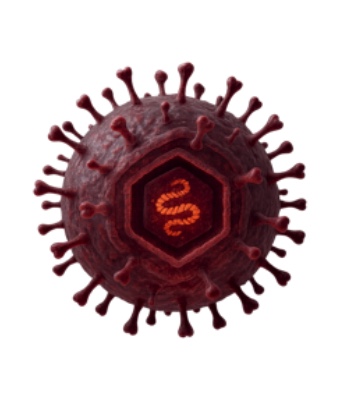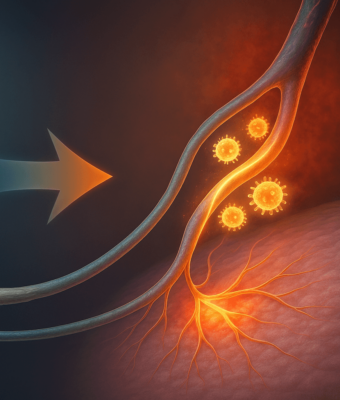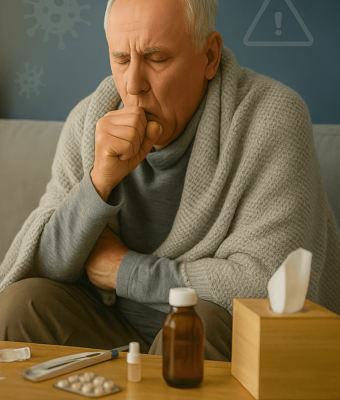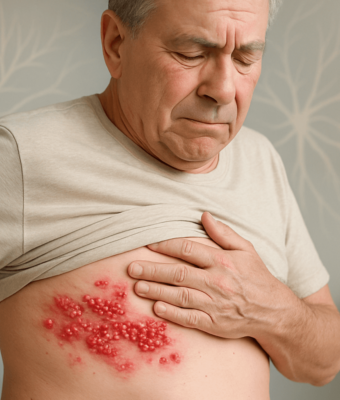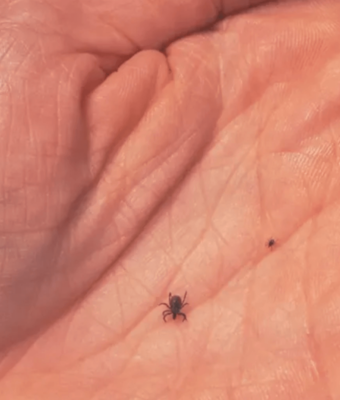Herpes zoster (HZ), commonly referred to as shingles “kenali cacar api” is a clinical condition resulting from the reactivation of the Varicella-Zoster Virus (VZV)—the same virus responsible for primary varicella (chickenpox). After resolution of the primary infection, the virus remains dormant in the dorsal sensory ganglia and may reactivate when cellular immunity declines.
Although often mistaken for a mild skin condition, shingles “kenali cacar api” can cause significant long-term morbidity, especially in older adults and immunocompromised patients. Thus, primary care physicians must be adept at recognizing early clinical features and managing the potential complications of shingles “kenali cacar api” effectively.
Following varicella infection, VZV travels along sensory nerves and establishes latency in dorsal root ganglia. Reactivation occurs due to a decline in VZV-specific cellular immunity, particularly CD4+ and CD8+ T cells, resulting in nerve inflammation and necrosis, followed by a vesicular eruption localized to the affected dermatome.
Clinical Manifestations of Herpes Zooster
1. Prodromal Symptoms
- Occur 1–5 days before the rash.
- Burning pain, tingling, or localized itching in a specific dermatome.
- Mild systemic symptoms: low-grade fever, malaise, headache.
2. Eruptive Phase
- Unilateral vesicular eruption along a dermatome.
- Lesions do not cross the midline (pathognomonic).
- Progression: macules → papules → vesicles → pustules → crusts within 7–10 days.
3. Most Common Locations
- Thoracic dermatomes (T3–L3): involved in : 50% of cases.
- Trigeminal nerve (V1 branch): associated with ophthalmic zoster.
- Lumbosacral: may cause urinary retention.
4. Additional Clinical Signs
- Severe neuropathic pain (may precede the rash).
- Allodynia or hyperalgesia.
- Multiple lesions in immunocompromised individuals.
Clinical Diagnosis of Herpes Zoster
Herpes zooster is typically diagnosed clinically but may be confirmed by:
- VZV-DNA PCR from vesicular fluid (gold standard).
- Tzanck smear: shows multinucleated giant cells (non-specific).
- Serologic testing (IgG/IgM): not sensitive for reactivation.
- Skin biopsy: useful in atypical cases or for differential diagnosis (e.g., HSV, impetigo, contact dermatitis).
Complications of Herpes Zoster
1. Postherpetic Neuralgia (PHN)
- Persistent neuropathic pain lasting ≥90 days after rash resolution.
- Incidence increases in patients >60 years.
- Risk factors: severe initial pain, facial or trunk involvement, delayed antiviral therapy.
2. Herpes Zoster Ophthalmicus
- Involves the ophthalmic branch (V1) of the trigeminal nerve.
- Symptoms: ocular pain, photophobia, decreased vision.
- Risks: keratitis, uveitis, potential permanent vision loss.
3. Herpes Zoster Oticus (Ramsay Hunt Syndrome)
- Involvement of the geniculate ganglion of the facial nerve.
- Symptoms: peripheral facial paralysis, vesicles in the ear canal, tinnitus, vertigo.
4. Secondary Bacterial Infection and Dissemination
Bacterial superinfection (e.g., S. aureus, S. pyogenes) → impetiginization.
- Disseminated zoster: may involve lungs, liver, or brain, especially in immunocompromised patients.
5. Neurological Complications
- Encephalitis, transverse myelitis, ischemic stroke (zoster vasculopathy).
- Higher risk in elderly or immunodeficient patients.
Primary Care Management of Herpes Zoster
1. Antiviral Therapy
Best initiated within 72 hours of rash onset.
Options:
- Acyclovir 800 mg 5x/day for 7 days.
- Valacyclovir 1 g 3x/day for 7 days.
- Famciclovir 500 mg 3x/day for 7 days.
- Note: Dosage adjustment required for renal impairment.
2. Pain Management
- NSAIDs/paracetamol for mild pain.
- Gabapentin/pregabalin, or TCAs (e.g., amitriptyline) for neuropathic pain.
- Topical lidocaine patches: effective for allodynia.
3. Prevention of Secondary Infection
- Maintain lesion hygiene; avoid vesicle rupture.
- Apply topical antibiotics if bacterial superinfection is suspected.
4. Patient Education and Isolation
- Avoid contact with non-immune individuals (e.g., infants, pregnant women, immunocompromised).
- Lesions are contagious until fully crusted.
Prevention: The Role of Vaccination
- Vaccination Indications
- Adults aged ≥50 years.
- Individuals with chronic illnesses or at risk of immunosuppression.
- Can be administered even if the patient has had a previous shingles episode.
- Vaccine Types
- Live-attenuated zoster vaccine : limited efficacy in older adults.
- Recombinant zoster vaccine : high efficacy, recommended by CDC.
Clinical Summary
Shingles “kenali cacar api” is not merely a superficial skin disease but a systemic viral reactivation that can lead to serious complications, particularly in vulnerable populations. Primary care physicians play a critical role in:
- Early recognition based on hallmark clinical symptoms.
- Timely initiation of antiviral therapy.
- Effective pain management to prevent PHN.
- Patient counseling and consideration for vaccination.
A comprehensive approach encompassing early detection, appropriate treatment, and preventive vaccination can significantly reduce clinical burden and improve patient quality of life.
References
- Dworkin RH, et al. Clinical Infectious Diseases. 2007;44(Suppl 1):S1–S26.
- Johnson RW, Rice AS. Herpes zoster postherpetic neuralgia: pathophysiology and management. BMJ. 2014;348:g3315.
- Yawn BP, Gilden D. Herpes zoster: A common disease causing serious complications. J Am Acad Dermatol. 2013;69(1):S2–S7.
- Indonesian Dermatology Association. Clinical Guideline for Herpes Zoster. 2023 edition.
About Docquity
If you need more confidence and insights to boost careers in healthcare, expanding the network to other healthcare professionals to practice peer-to-peer learning might be the answer. One way to do it is by joining a social platform for healthcare professionals, such as Docquity.
Docquity is an AI-based state-of-the-art private & secure continual learning network of verified doctors, bringing you real-time knowledge from thousands of doctors worldwide. Today, Docquity has over 400,000 doctors spread across six countries in Asia.
Meet experts and trusted peers across Asia where you can safely discuss clinical cases, get up-to-date insights from webinars and research journals, and earn CME/CPD credits through certified courses from Docquity Academy. All with the ease of a mobile app available on Android & iOS platforms!

